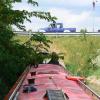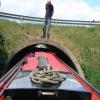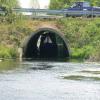
There is a bridge here which takes a minor road over the canal.
| Bettinson's Bridge | 1 mile, 4 furlongs | |
| Bettinson's Bridge Winding Hole | 1 mile, 4 furlongs | |
| Hough Bridge | 6½ furlongs | |
| Houghbridge Drain - Sandy Bank Drain Junction | 3¾ furlongs | |
| Bunker's Hill Bridge | ||
| Westville Footbridge | 6 furlongs | |
| Newham Drain - Howbridge Drain - West Fen Drain Junction | 7¼ furlongs | |
Why not log in and add some (select "External websites" from the menu (sometimes this is under "Edit"))?
Mouseover for more information or show routes to facility
Nearest water point
In the direction of Newham Drain - Howbridge Drain - West Fen Drain Junction
Nearest rubbish disposal
In the direction of Newham Drain - Howbridge Drain - West Fen Drain Junction
Nearest chemical toilet disposal
In the direction of Newham Drain - Howbridge Drain - West Fen Drain Junction
Nearest place to turn
In the direction of Bettinson's Bridge
In the direction of Newham Drain - Howbridge Drain - West Fen Drain Junction
No information
CanalPlan has no information on any of the following facilities within range:self-operated pump-out
boatyard pump-out
Wikipedia has a page about Bunker's Hill Bridge
A bunker is a defensive military fortification designed to protect people and valued materials from falling bombs or other attacks. Bunkers are mostly underground, in contrast to blockhouses which are mostly above ground. They were used extensively in World War I, World War II, and the Cold War for weapons facilities, command and control centers, and storage facilities. Bunkers can also be used as protection from tornadoes.
Trench bunkers are small concrete structures, partly dug into the ground. Many artillery installations, especially for coastal artillery, have historically been protected by extensive bunker systems. Typical industrial bunkers include mining sites, food storage areas, dumps for materials, data storage, and sometimes living quarters. When a house is purpose-built with a bunker, the normal location is a reinforced below-ground bathroom with fibre-reinforced plastic shells. Bunkers deflect the blast wave from nearby explosions to prevent ear and internal injuries to people sheltering in the bunker. Nuclear bunkers must also cope with the underpressure that lasts for several seconds after the shock wave passes, and block radiation.
A bunker's door must be at least as strong as the walls. In bunkers inhabited for prolonged periods, large amounts of ventilation or air conditioning must be provided. Bunkers can be destroyed with powerful explosives and bunker-busting warheads.















